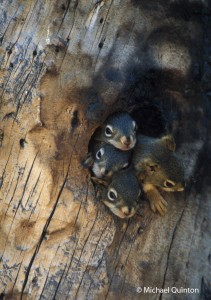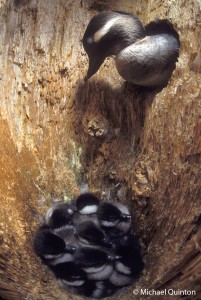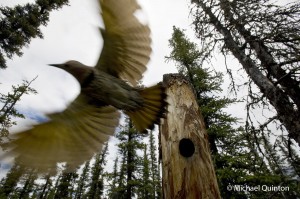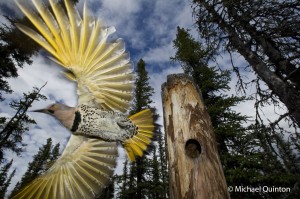 For more than two months this male northern flicker and his mate maintain a territory centered around their nesting cavity in an Alaskan black spruce forest. Flickers are the most common woodpecker in Alaska’s interior.
For more than two months this male northern flicker and his mate maintain a territory centered around their nesting cavity in an Alaskan black spruce forest. Flickers are the most common woodpecker in Alaska’s interior.
 The female peers out of the cavity containing seven naked chicks.
The female peers out of the cavity containing seven naked chicks.
 Male flicker approaching side of nesting snag for verticle landing.
Male flicker approaching side of nesting snag for verticle landing.
 Articulating wings pivot for complex, final adjustments in approach.
Articulating wings pivot for complex, final adjustments in approach.
 Male peers into the snag before entering to feed the chicks by regurgitating. Ants, adults, larva and eggs are their primary food which they collect with their long, sticky tongue to probe tunnels in wood and underground.
Male peers into the snag before entering to feed the chicks by regurgitating. Ants, adults, larva and eggs are their primary food which they collect with their long, sticky tongue to probe tunnels in wood and underground.
 With a flash of gold, the male explodes from the cavity after feeding chicks.
With a flash of gold, the male explodes from the cavity after feeding chicks.
 As the young grow there is intense competition to be in front of the line at feeding time.
As the young grow there is intense competition to be in front of the line at feeding time.
 Juvinile flickers ready to fledge spend their final day in the nesting cavity. Adults have been tempting them out of the nest by calling from nearby perches and withholding food.
Juvinile flickers ready to fledge spend their final day in the nesting cavity. Adults have been tempting them out of the nest by calling from nearby perches and withholding food.
 Northern flickers, though speedy fliers, are preyed upon by even faster raptors like the northern goshawk and the northern hawk owl.
Northern flickers, though speedy fliers, are preyed upon by even faster raptors like the northern goshawk and the northern hawk owl.
 Northern hawk owl with yellow-shafted flicker on the butcher block.
Northern hawk owl with yellow-shafted flicker on the butcher block.
Young red squirrels find their old flicker hole safe and secure but maybe a bit short on elbow room. Abandoned flicker cavities are in high demand as wild nurseries for a variety of small wildlife including boreal owls, tree swallows, bluebirds, and a family of day old bufflehead ducks. (right)
PHOTO TIP
With Flash
The most striking quality of the northern flicker is the dramatic yellow underwing and tail. Using an electronic flash brings out this beautiful detail.




